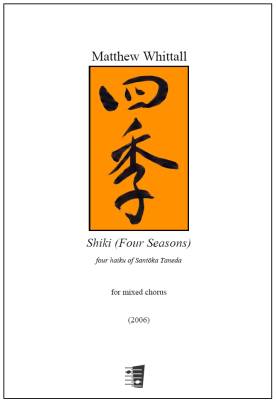Shiki (Four Seasons) for mixed chorus — Four haiku of Santoka Taneda SATB
Whittall, MatthewTuotetiedot
| Nimeke: | Shiki (Four Seasons) for mixed chorus — Four haiku of Santoka Taneda SATB | ||
| Tekijät: | Whittall, Matthew (Säveltäjä) Taneda, Shantoka (Sanoittaja) |
||
| Tuotetunnus: | 9790550113480 | ||
| Tuotemuoto: | Nuotti | ||
| Saatavuus: | Toimitusaika 7-16 päivää | ||
| Hinta: | 17,72 € (15,54 € alv 0 %) | ||
|
|||
| Kustantaja: | Fennica Gehrman |
| Painos: | 2017 |
| Julkaisuvuosi: | 2017 |
| Kieli: | japani |
| Sivumäärä: | 42 |
| Tuoteryhmät: | Kuoroteokset Sekakuoro |
| Kirjastoluokka: | 78.3411 Sekakuorot |
Shiki began as a request for a short winter-themed piece for the Hämäläis-Osakunnan Laulajat choir in Helsinki. It eventually grew into a four seasons-type cycle on haiku by a 20th century Japanese monk Santoka Taneda.
The music of Shiki is a progression through various states of near-stasis. The main impression the composer wished to convey was the one of absolute stillness at the heart of each scene, of communion with the outer world, as if the viewer were drawing the landscape into him, and at the same time dissolving himself into it. The voices are treated texturally, as well as textually, moving on slow masses, with the soft but precisecely colored vowels of Japanese creating the basic sounds, and the sharper consonants giving them shape and definition.
Shikin juuret ovat Hämäläis-Osakunnan laulajien pyynnössä säveltää heille lyhyt talvi-aiheinen kuoroteos. Lopputulemana oli kuitenkin neliosainen vuodenaikoja japanilaisen 1900-luvulla eläneen munkin Santoka Tanedan haiku-runoihin. Shikin musiikki on lähes pysähtynyttä. Kuorosatsi muistuttaa ajoittain enemmän elektronimusiikkia, kuin perinteistä kuorolaulantaa. Whittall on pohjattoman kiinnostunut ihmisäänen mahdollisuuksista sekä äänteiden hitaasta muuttumisesta. Japanin kielen terävät konsonantit rytmittävät hidasta, lähes staattista tilaa. Myös kuoron sijoittelu hakee inspiraatiota muinaisista rituaaleista.
The music of Shiki is a progression through various states of near-stasis. The main impression the composer wished to convey was the one of absolute stillness at the heart of each scene, of communion with the outer world, as if the viewer were drawing the landscape into him, and at the same time dissolving himself into it. The voices are treated texturally, as well as textually, moving on slow masses, with the soft but precisecely colored vowels of Japanese creating the basic sounds, and the sharper consonants giving them shape and definition.
Shikin juuret ovat Hämäläis-Osakunnan laulajien pyynnössä säveltää heille lyhyt talvi-aiheinen kuoroteos. Lopputulemana oli kuitenkin neliosainen vuodenaikoja japanilaisen 1900-luvulla eläneen munkin Santoka Tanedan haiku-runoihin. Shikin musiikki on lähes pysähtynyttä. Kuorosatsi muistuttaa ajoittain enemmän elektronimusiikkia, kuin perinteistä kuorolaulantaa. Whittall on pohjattoman kiinnostunut ihmisäänen mahdollisuuksista sekä äänteiden hitaasta muuttumisesta. Japanin kielen terävät konsonantit rytmittävät hidasta, lähes staattista tilaa. Myös kuoron sijoittelu hakee inspiraatiota muinaisista rituaaleista.




